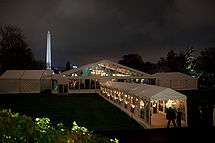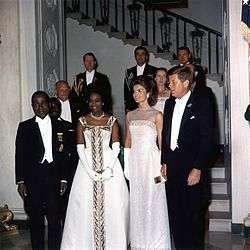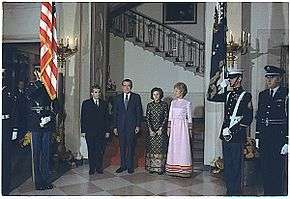State dinner

A state dinner or state lunch is a dinner or banquet paid for by a government and hosted by a head of state in his or her official residence in order to renew and celebrate diplomatic ties between the host country and the country of a foreign head of state or head of government who was issued an invitation. It may form part of a state visit or diplomatic conference. In many countries around the world, there are many different rules governed by protocol. State dinners often consist of, but are not limited to, black tie or white tie dress, military honor guards, a four or five course meal, musical entertainment, dancing, and speeches made on behalf of the head of state hosting the state dinner as well as the foreign head of state.
By country
India

In India, state banquets are held for foreign heads of state and government at the Rashtrapati Bhavan in New Delhi and are hosted by the President of India. Over one hundred guests usually attend state banquets, including members of the Government of India such as the Vice-President of India, the Prime minister of India, and prominent members of the ruling party. Indian and foreign business leaders also attend.
At the beginning of a state banquet, a foreign head of state is greeted by the president in the North Drawing Room. A tent constructed in the Mughal Garden within the environs of the presidential palace is the outdoor setting for state banquets. During the evening, the gardens are lit up with earthen diyas, string lights, and decorated with flowers and rangoli that become a scene for entertainment. After a performance by Rajasthani singers, Indian percussion instruments like the mridangam, tabla, ghatam and khanjeera, as well as India's diverse classical dances in which Bharatnatyam, Odissi and Kathak are carefully choreographed, will all be showcased in front of the guests.
Inside the tent, speeches highlighting bilateral diplomatic relations are delivered by the President of India and the foreign head of state. The guests are then offered a sumptuous meal of Indian delicacies while the Indian Navy Band performs music.
State banquets follow an official arrival ceremony which occurs at the Rashtrapati Bhavan earlier in the day.
United Kingdom
In the United Kingdom, state dinners are hosted by the head of state, who is the British sovereign, currently Queen Elizabeth II. Traditionally all state dinners were held at Buckingham Palace because of its position in the heart of London. However, in recent years, banquets have also been held at Windsor Castle in Berkshire. Organisation of the state dinner usually falls to the Master of the Household with a seating plan confirmed both by the Queen and the Foreign and Commonwealth Office. State dinners are usually held for visiting heads of state and are very elaborate; Royal Protocol is generally very strict but this has been played down over recent years. All speeches that are read are again checked and confirmed by the Foreign office, and amended. Gifts are exchanged by both parties.
United States
Introduction

In the United States, a state dinner is a formal dinner, more often black tie in recent years rather than white tie, which is held in honor of a foreign head of state, such as a king, queen, president, or any head of government. A state dinner is hosted by the President of the United States and held in the State Dining Room at the White House in Washington D.C. Other formal dinners for important people of other nations, such as a prince or princess, are called official dinners, the difference being that the federal government does not pay for them.
State and official dinners are dictated by strict protocol in order to ensure that no diplomatic gaffes occur. The Chief of Protocol of the United States, who is an official within the United States Department of State, the White House Chief Usher, who is head of the household staff at the White House, as well as the White House Social Secretary all oversee the planning of state and official dinners from beginning to end. The Graphics and Calligraphy Office located in the East Wing of the White House also bears numerous responsibilities. The White House Chief Calligrapher creates place cards with the names of the guests who are assigned seats around the tables in the State Dining Room. The Chief Calligrapher also designs and writes formal invitations that are mailed to the postal addresses of the guests. State dinners require close coordination between the White House Executive Chef and the White House Executive Pastry Chef who plan and prepare a four or five-course meal, as well as the White House Chief Floral Designer who arranges flowers and decorations on the candle-lit tables.
As is customary for all incoming state visits by foreign heads of state, a state dinner follows a State Arrival Ceremony which occurs on the South Lawn earlier in the day. In addition, state dinners held in recent years are also given media coverage by the public affairs TV channel, C-SPAN.
History
%2C_b._1850_3.jpg)
In the early 19th century, dinners honoring the president's Cabinet, Congress, or other dignitaries were called 'state dinners' even though they lacked official foreign representation. Under such conditions, large receptions and dinners were a rare occurrence as Washington, D.C., society was a collection of isolated villages widely separated and at times almost inaccessible. Times changed and so did the nation’s capital as a series of state dinners were held every winter social season to honor Congress, the Supreme Court, and members of the diplomatic corps.
In the late 19th century, the term state dinner became synonymous with a dinner hosted by the president honoring a foreign head of state. The first visiting head of state to attend a state dinner at the White House was King David Kalakaua of the Kingdom of Hawaii, hosted by Ulysses S. Grant on December 12, 1874.[1]
The restoration of the White House by the architectural firm McKim, Mead, and White in 1902 created a more proper setting for official entertainment to occur. When the president's office moved to the newly constructed West Wing, the Neoclassical remodeling of the Executive Residence's state rooms gave Theodore Roosevelt a perfect venue reflecting the United States' growing power and influence around the world. While the White House underwent a complete interior reconstruction from 1948 to 1952, Harry S. Truman and Bess Truman lived at Blair House and state dinners were held in local hotels in the nation's capital. Long banquet tables were always used in the State Dining Room prior to the administration of John F. Kennedy. However, these were permanently discarded by Jacqueline Kennedy and replaced with round tables which could seat a far greater number of guests, approximately 120 to 140, in such a tight and confined space. To this day, presidents and first ladies continue to add their own personal touches and flair in entertaining foreign guests of state at the White House, having full access to the vermeil collection of gilded candelabras and flatware, the President's House crystal pattern, as well as the priceless collection of White House china which dates from the James Monroe administration to the George W. Bush administration, for use at a state dinner.[1]
Sequence of events


During a state dinner, honor guards and color guards in full dress uniform from all branches of the United States Armed Forces are dispatched for ceremonial duty at the White House. At the North Portico entrance of the White House, the President of the United States and the First Lady of the United States formally greet the visiting head of state and his or her spouse, who have arrived in a motorcade from Blair House, the traditional guest quarters of foreign heads of state and dignitaries, or from a foreign ambassador's residence in the area of Embassy Row in Northwest, Washington, D.C. A brief photo opportunity for the media at the top of the staircase will occur. The president and first lady then escort the visiting head of state and his or her spouse to the Yellow Oval Room for a reception on the residence floor where the president's guests are served hors d'œuvres, cocktails, wine, or champagne. The president and first lady also introduce their guests to a wide array of people from the United States such as ambassadors, diplomats, members of Congress, members of the president's Cabinet, and other prominent people such as celebrities and Hollywood A-list movie stars invited at the discretion of the president and first lady.
After the informal reception in the Yellow Oval Room, the president and the foreign head of state, followed by the first lady and the foreign head of state's spouse, descend the Grand Staircase to the Entrance Hall on the state floor where they are met by the United States Marine Band, "The President's Own". Four ruffles and flourishes, immediately followed by Hail to the Chief, serves as the fanfare for the president's arrival. Often, the national anthem of the foreign head of state's country as well as the Star Spangled Banner are performed.
After a receiving line whereby the president introduces the visiting head of state to all of the invited guests, the president and the visiting head of state, his or her spouse, and the first lady, walk down the Cross Hall and proceed to the State Dining Room where a four or five-course meal, typically consisting of an appetizer/soup, fish, meat, salad and dessert, are served to the guests. The menu planned in advance for a state dinner and prepared by the White House Executive Chef and White House Executive Pastry Chef centers around the national cuisine of the visiting foreign head of state, using local ingredients, flavors, and ethnic foods. Before eating the meal, both the president and the visiting foreign head of state give a speech on a lectern, paying tribute to diplomatic relations between the United States and the foreign head of state's country. Members of the "Strolling Strings," violinists from the United States Marine Band "The President's Own," disperse throughout the State Dining Room and perform for the guests seated around the candle-lit tables. After the meal, the guests are seated in the East Room and are formally entertained by a musical ensemble such as a pianist, a singer, an orchestra, or band of national renown. On past occasions, dancing has also been a component at the conclusion of a state dinner.
Switzerland
In Switzerland, the head of the state is the Swiss Federal Council (not only its president). For this reason, the seven Federal Councillors (and their spouses) are invited to the state dinners organised in Bern during state visits.[2]
Gallery
 President Dwight D. Eisenhower and First Lady Mamie Eisenhower in a photo opportunity with King Bhumibol Adulyadej of Thailand and his consort, Queen Sirikit of Thailand, prior to a state dinner held on June 14, 1960.
President Dwight D. Eisenhower and First Lady Mamie Eisenhower in a photo opportunity with King Bhumibol Adulyadej of Thailand and his consort, Queen Sirikit of Thailand, prior to a state dinner held on June 14, 1960. President John F. Kennedy, First Lady Jacqueline Kennedy, President Félix Houphouët-Boigny and Madame Marie-Thérèse Houphouët-Boigny of Côte d'Ivoire in the Entrance Hall prior to a state dinner held on May 22, 1962.
President John F. Kennedy, First Lady Jacqueline Kennedy, President Félix Houphouët-Boigny and Madame Marie-Thérèse Houphouët-Boigny of Côte d'Ivoire in the Entrance Hall prior to a state dinner held on May 22, 1962. President Lyndon B. Johnson, First Lady Lady Bird Johnson, Israeli Prime Minister Levi Eshkol and his spouse Miriam Eshkol, in the Entrance Hall prior to a state dinner held on June 1, 1964.
President Lyndon B. Johnson, First Lady Lady Bird Johnson, Israeli Prime Minister Levi Eshkol and his spouse Miriam Eshkol, in the Entrance Hall prior to a state dinner held on June 1, 1964. President Richard Nixon, First Lady Pat Nixon, Romanian President Nicolae Ceaușescu and his spouse First Lady Elena Ceaușescu, in the Entrance Hall prior to a state dinner held on December 4, 1973.
President Richard Nixon, First Lady Pat Nixon, Romanian President Nicolae Ceaușescu and his spouse First Lady Elena Ceaușescu, in the Entrance Hall prior to a state dinner held on December 4, 1973. A menu during a state dinner held for King Hussein of Jordan on the evening of August 16, 1974.
A menu during a state dinner held for King Hussein of Jordan on the evening of August 16, 1974. President Gerald Ford, First Lady Betty Ford, Japanese Emperor Hirohito, and Japanese Empress Kōjun walking down the Cross Hall to the East Room during a state dinner held on October 2, 1975.
President Gerald Ford, First Lady Betty Ford, Japanese Emperor Hirohito, and Japanese Empress Kōjun walking down the Cross Hall to the East Room during a state dinner held on October 2, 1975. President Jimmy Carter and First Lady Rosalynn Carter dining with German Chancellor Helmut Schmidt and Loki Schmidt during a state dinner held in the State Dining Room on July 13, 1977.
President Jimmy Carter and First Lady Rosalynn Carter dining with German Chancellor Helmut Schmidt and Loki Schmidt during a state dinner held in the State Dining Room on July 13, 1977. President Ronald Reagan, First Lady Nancy Reagan, Chinese President Li Xiannian and his spouse First Lady Lin Jiamei, at the North Portico entrance of the White House prior to a state dinner held on July 23, 1985.
President Ronald Reagan, First Lady Nancy Reagan, Chinese President Li Xiannian and his spouse First Lady Lin Jiamei, at the North Portico entrance of the White House prior to a state dinner held on July 23, 1985. President George H.W. Bush, Russian President Boris Yeltsin, First Lady Barbara Bush, and Naina Yeltsina descending the Grand Staircase during a state dinner held on June 16, 1992.
President George H.W. Bush, Russian President Boris Yeltsin, First Lady Barbara Bush, and Naina Yeltsina descending the Grand Staircase during a state dinner held on June 16, 1992..jpg) President George W. Bush and First Lady Laura Bush in a photo opportunity with Queen Elizabeth II and her consort, Prince Philip, Duke of Edinburgh, at the North Portico entrance of the White House prior to a state dinner held on May 7, 2007.
President George W. Bush and First Lady Laura Bush in a photo opportunity with Queen Elizabeth II and her consort, Prince Philip, Duke of Edinburgh, at the North Portico entrance of the White House prior to a state dinner held on May 7, 2007. President Barack Obama and First Lady Michelle Obama greet French President François Hollande at the North Portico entrance of the White House prior to a state dinner held on February 11, 2014.
President Barack Obama and First Lady Michelle Obama greet French President François Hollande at the North Portico entrance of the White House prior to a state dinner held on February 11, 2014.
See also
- China Room
- State Arrival Ceremony
- State Dining Room
- State funeral
- State funerals in Canada
- State funerals in the United Kingdom
- State funerals in the United States
- State visit
- White House china
References
- 1 2 "The White House State Dinner" (PDF). The White House Historical Association. Retrieved 2009-07-21.
- ↑ Le Temps, Saturday 18 April 2015, page 10.
- Schifando, Peter; J. Jonathan Joseph (2007). Entertaining at the White House with Nancy Reagan. New York: William Morrow. ISBN 978-0-06-135012-2.